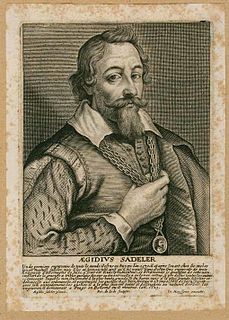
Antonio Lucio Vivaldi was an Italian Baroque composer, virtuoso violinist, teacher, impresario, and Roman Catholic priest.

Giovanni BattistaPiranesi was an Italian Classical archaeologist, architect, and artist, famous for his etchings of Rome and of fictitious and atmospheric "prisons". He was the father of Francesco Piranesi and Laura Piranesi.

Andrea Mantegna was an Italian painter, a student of Roman archeology, and son-in-law of Jacopo Bellini.

Francesco Bartolozzi was an Italian engraver, whose most productive period was spent in London. He is noted for popularizing the "crayon" method of engraving.

Felice Anerio was an Italian composer of the late Renaissance and early Baroque eras, and a member of the Roman School of composers. He was the older brother of another important, and somewhat more progressive composer of the same period, Giovanni Francesco Anerio.

Marcantonio Raimondi, often called simply Marcantonio, was an Italian engraver, known for being the first important printmaker whose body of work consists largely of prints copying paintings. He is therefore a key figure in the rise of the reproductive print. He also systematized a technique of engraving that became dominant in Italy and elsewhere. His collaboration with Raphael greatly helped his career, and he continued to exploit Raphael's works after the painter's death in 1520, playing a large part in spreading High Renaissance styles across Europe. Much of the biographical information we have comes from his life, the only one of a printmaker, in Vasari's Lives of the Artists.

The Sadeler family were the largest, and probably the most successful of the dynasties of Flemish engravers that were dominant in Northern European printmaking in the later 16th and 17th centuries, as both artists and publishers. As with other dynasties such as the Wierixes and Van de Passe family, the style of family members is very similar, and their work often hard to tell apart in the absence of a signature or date, or evidence of location. Altogether at least ten Sadelers worked as engravers, in the Spanish Netherlands, Germany, Italy, Bohemia and Austria.

Cosimo Bartoli was an Italian diplomat, mathematician, philologist, and humanist. He worked and lived in Rome and Florence and took minor orders. He was a friend of architect and writer Giorgio Vasari, and helped him to get his Vite ready for publication.

Antonio Visentini was an Italian architectural designer, painter and engraver, known for his architectural fantasies and capricci, the author of treatises on perspective and a professor at the Venetian Academy.
Vittorio Baldini was an Italian printer and engraver. He started publishing in Venice, where he was born, and later moved to Ferrara, joining the court of Duke Alfonso II d'Este in mid-to-late 1582, where he was the official ducal music printer. He may have met the duke through Giulio Cesare Brancaccio, whose translation and commentary on Julius Caesar's Commentarii de Bello Gallico Baldini printed in early 1582.

Francesco Rosselli was an Italian miniature painter, and engraver of maps and old master prints. He was described as a cartographer, although his contribution did not include any primary research and was probably limited to engraving, decorating and selling manuscript maps created by others. He created many maps, including one of the first printed maps of the world to depict the Americas after Christopher Columbus' voyages. The attribution of prints to him is the subject of debate, as different engraving styles are used. This may be the result of different artists in his workshop, or of his and his shop's ability to use different styles.

Jacopo de' Barbari, sometimes known or referred to as de'Barbari, de Barberi, de Barbari, Barbaro, Barberino, Barbarigo or Barberigo, was an Italian painter, printmaker and miniaturist with a highly individual style. He moved from Venice to Germany in 1500, thus becoming the first Italian Renaissance artist of stature to work in Northern Europe. His few surviving paintings include the first known example of trompe-l'œil since antiquity. His twenty-nine engravings and three very large woodcuts were also highly influential.

Andrea Antico was a music printer, editor, publisher and composer of the Renaissance born in the Republic of Venice, of Istrian birth, active in Rome and in Venice. He was the first printer of sacred music in Rome, and the earliest competitor of Venetian Ottaviano Petrucci, who is regarded as the first significant music printer.
The first decade of the 16th century marked the creation of some significant compositions. These were to become some of the most famous compositions of the century.
Pietro Taglia was an Italian composer of the Renaissance, active in Milan, known for his madrigals. Stylistically he was a progressive, following the innovations of more famous composers such as Cipriano de Rore in Venice, and his music was well-known at the time.

Diana Scultori, Diana Mantuana, or Diana Ghisi (1547–1612) was an Italian engraver from Mantua, Italy. She is one of the earliest known women printmakers, making mostly reproductive engravings of well-known paintings or drawings, especially those of Raphael and Giulio Romano, or ancient Roman sculptures.

Martino Rota, also Martin Rota and Martin Rota Kolunić was an artist, now mainly known for his printmaking, from Dalmatia.

Petrus, or Pieter de Jode I or Pieter de Jode the Elder, was a Flemish printmaker, draughtsman, publisher and painter active principally active in Antwerp. He was active as a reproductive artist who created many prints after the works of leading painters and was in addition a prolific designer of prints for Antwerp publishers.

Pauwels Franck, known in Italy as Paolo Fiammingo and Paolo Franceschi, was a Flemish painter, who, after training in Antwerp, was active in Venice for most of his life. He is mainly known for his landscapes with mythological, allegorical and religious scenes. He worked in a Mannerist style showing the influence of Tintoretto, Veronese, and Bassano.

Francesco de' Franceschi was an Italian Renaissance painter. His exact dates of birth and death are not known.




















